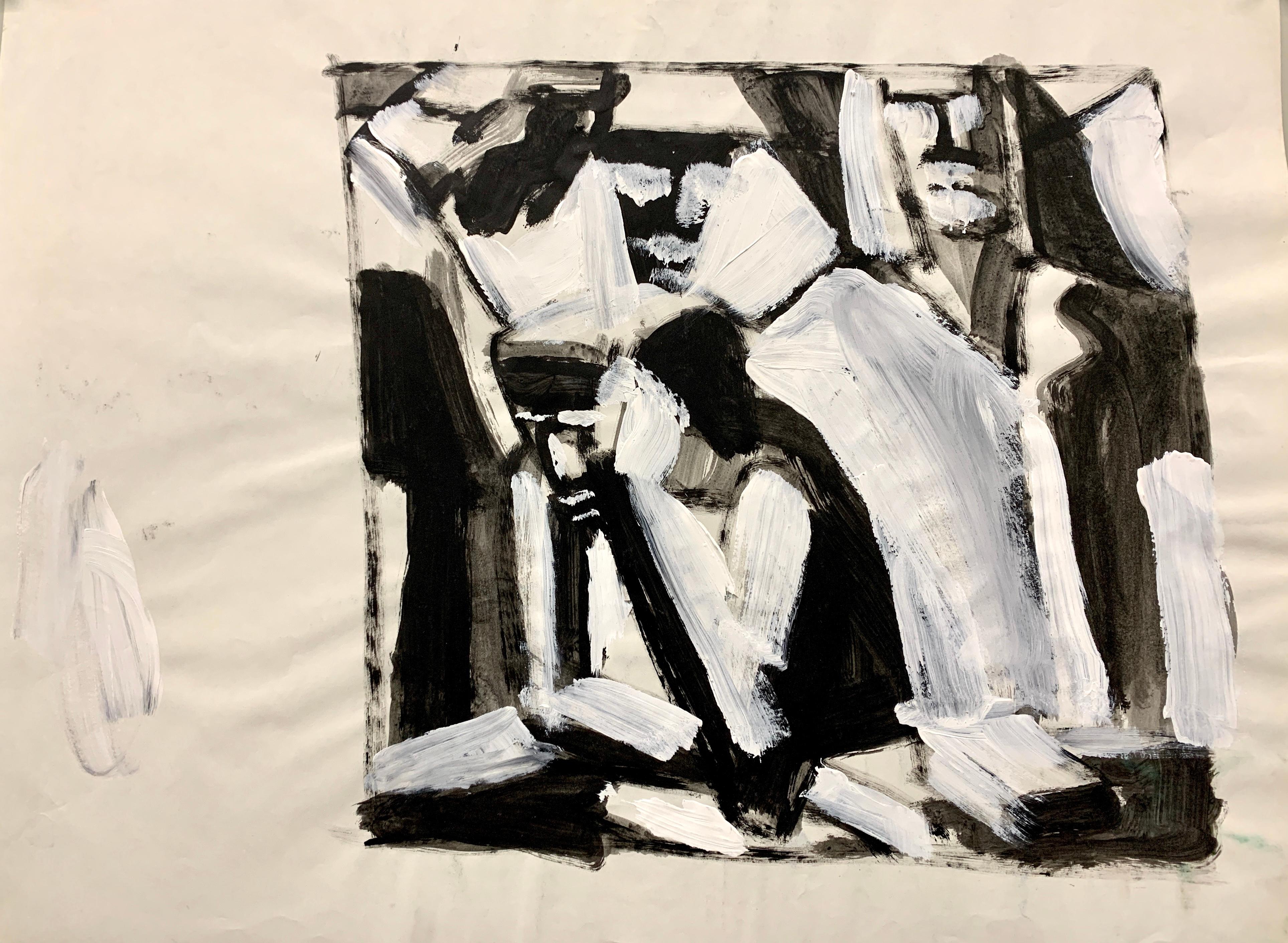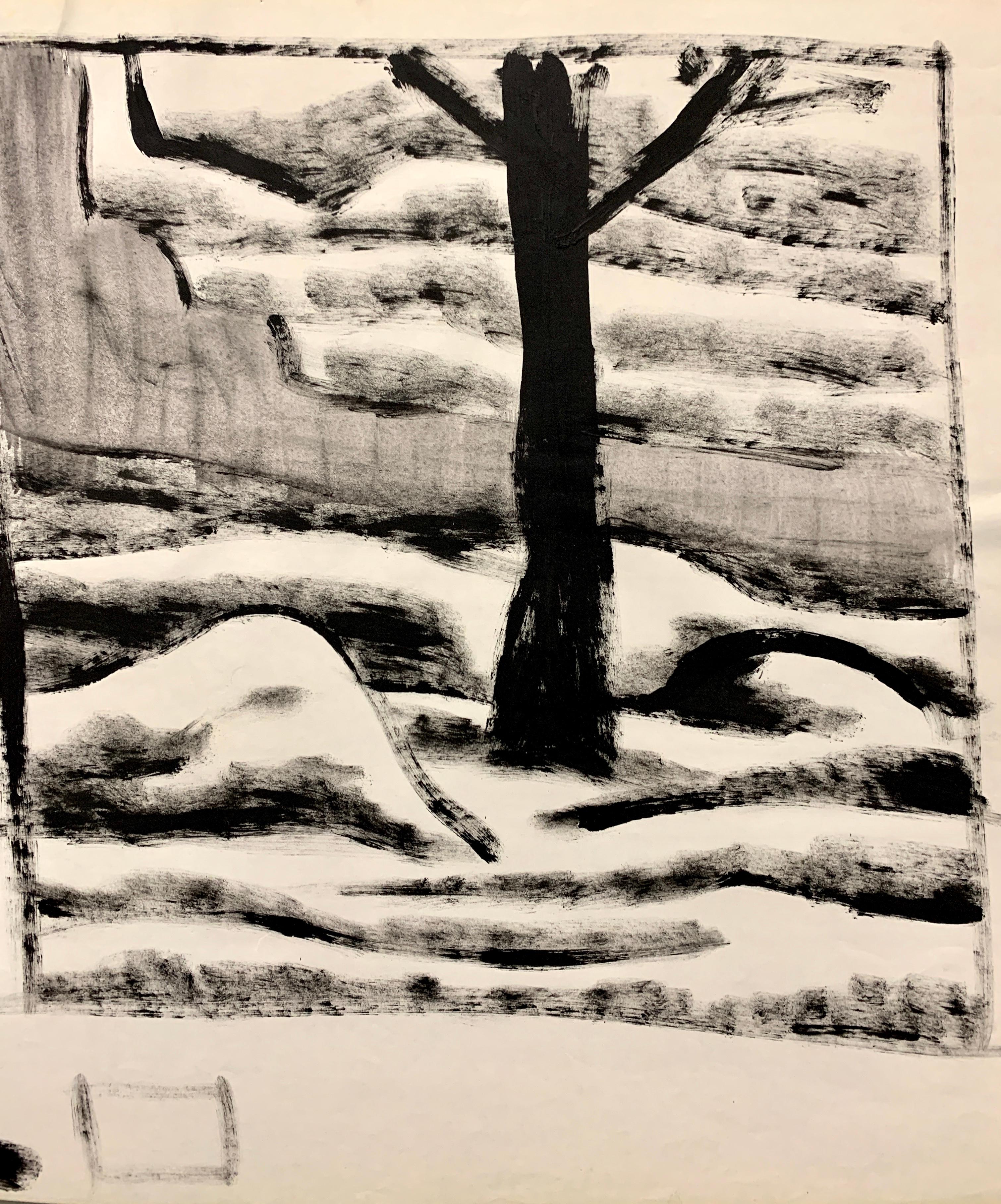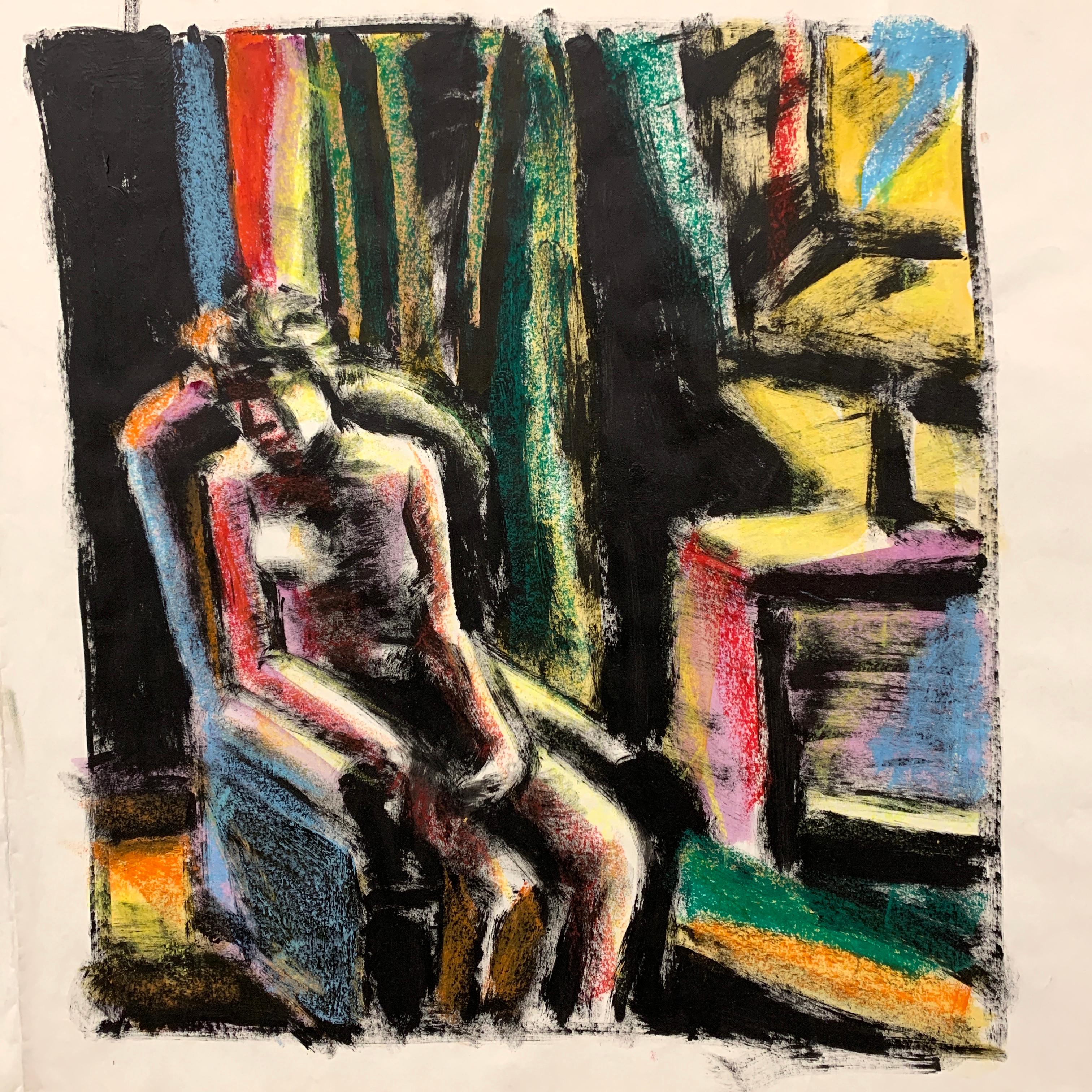Items Similar to Untitled [Abstraction]
Want more images or videos?
Request additional images or videos from the seller
1 of 8
George L.K. MorrisUntitled [Abstraction]c. late 1940s
c. late 1940s
About the Item
Gouache on paper, 18 7/8 x 14 3/4 in.
Signed (at lower right): Morris; (with monogram, on the back): GLKM [monogram] / 1932 [sic]
Executed circa late 1940s
A passionate advocate of abstract art during the 1930s and 1940s, George L. K. Morris was active as a painter, sculptor, editor, and critic. An erudite man with an internationalist point of view, Morris
eschewed the social, political, and figural concerns that preoccupied so many artists of Depression-era America, believing that painters should focus their attention on the beauty, refinement, and simplicity of pure form instead. His goal, he said, was “to wedge the expression further and further into the confines of the canvas until every shape takes on a spatial meaning” (as quoted in Ward Jackson, “George L. K. Morris: Forty Years of Abstract Art,” Art Journal 32 [Winter 1972–73], p. 150).
Born into an affluent family in New York City, Morris was a descendent of General Lewis Morris, a
signer of the Declaration of Independence. From 1918 until 1924, he attended the Groton School in
Connecticut, studying classics and art. He continued to focus on literature and art while attending
Yale University (1924–28), an experience that prepared him well for his future activity as an artist-critic. After graduating in 1928, Morris studied at the Art Students League of New York, working
under the realist painters John Sloan and Kenneth Hayes Miller, as well as Jan Matulka, the only
modernist on the faculty. In the spring of 1929, Morris traveled to Paris with Albert E. Gallatin, a
family friend and fellow painter who introduced him to leading members of the Parisian avant-garde, including Jean Arp, Pablo Picasso, Georges Braque, Jean Hélion, and Piet Mondrian. Morris also took classes at the Académie Moderne, studying under Fernand Léger and Amédée Ozenfant, important exponents of Synthetic Cubism who influenced his aesthetic development. Indeed, after experimenting with the simplified forms of Modernism for a few years, Morris moved on to abstraction by 1934, adopting a hard-edged, geometric approach inspired by Leger’s cubist style and the biomorphic shapes of Arp and Joan Miró.
Following his return to New York in 1930, Morris built a white-walled, open-spaced studio (inspired
by that of Ozenfant, which had been designed by Le Corbusier) on the grounds of Brockhurst, his
parents’ 46-acre estate in Lenox, Massachusetts. In 1935, he married the painter and collagist Estelle “Suzy” Frelinghuysen (1911–1988), who shared his penchant for abstraction. One year later, the couple helped found American Abstract Artists, a group of forward-thinking artists dedicated to promoting geometric abstraction in the United States.
Untitled features a tight, mosaic-like network of squares (some plain, others embedded with circles) contained within carefully delineated contours set against a backdrop of radiating color planes that converge on the segmented disc that serves as the focal point of the composition. (The evolution of Morris’s style, as he moved from a tentative modernist aesthetic to the type of geometric abstraction exemplified in Untitled is apparent upon perusal of the verso of the sheet, which features a watercolor study from 1932. The summarily rendered shapes suggest the influence of Henri Matisse, who Morris had met in New York in 1931, while the fragmented lines point to his growing penchant for Cubism. Despite the high degree of stylization, however, the site can easily be identified as the Pulitzer Fountain in Manhattan’s Grand Army Plaza [at the southeast entrance to Central Park across from the Plaza Hotel], a well-known landmark crowned by Karl Bitter’s allegorical bronze sculpture, Pomona, the Roman goddess of abundance [erected 1916].) By altering the sizes of the patches and juxtaposing solid areas of color (blue, black, and white) with subtle greys, tans, and pale pinks, Morris creates a tunnel-like sense of depth while retaining the tension and structural integrity of the two-dimensional picture plane. The artist’s kaleidoscope-like arrangement of planar forms readily brings to mind the words of the critic Frank Getlein, who described the effect as being “somewhat similar to that of looking down the well of a staircase” (Frank Getlein, “Knaths and Morris in Washington,” The New Republic 152 [May 15, 1965], n.p.).
In 1941, Morris and Freylinghusen added a streamlined, Bauhaus-inspired residence (designed by
John Butler Swann) on to their Lenox studio, selling one of their Picassos to underwrite the cost.
(Decorated with their own frescoes, modernist furniture, and their extensive collection of abstract art, the Frelinghuysen Morris House & Studio is listed on the National Register of Historic Places and has been open to the public since 1998.) After his solo debut at the Valentine Gallery in New York in 1933, Morris went on to exhibit his work in other leading commercial establishments, among them Edith Halpert’s legendary Downtown Gallery, the Reinhardt Galleries, the Alan Gallery, and Hirschl & Adler Galleries, as well as at venues abroad, including Galerie Pierre and Galerie Colette Allendy in Paris and the Mayor Gallery in London. He also had one-man shows at the Berkshire Museum in 1933 and 1966 and at Yale University in 1935. Morris likewise participated in the annual exhibitions at the National Academy of Design, the Whitney Museum of American Art, the Pennsylvania Academy of the Fine Arts, the Carnegie Institute, and the Art Institute of Chicago. He continued to exhibit his work into the early 1970s, winning the National Academy’s Saltus Gold Medal in 1973. Morris died on June 26, 1975, following an automobile accident near Stockbridge, Massachusetts.
- Creator:George L.K. Morris (1905-1975, American)
- Creation Year:c. late 1940s
- Dimensions:Height: 18.88 in (47.96 cm)Width: 14.75 in (37.47 cm)
- Medium:
- Movement & Style:
- Period:
- Condition:
- Gallery Location:New York, NY
- Reference Number:
About the Seller
5.0
Recognized Seller
These prestigious sellers are industry leaders and represent the highest echelon for item quality and design.
Established in 1952
1stDibs seller since 2010
32 sales on 1stDibs
Typical response time: 11 hours
Associations
Art Dealers Association of America
- ShippingRetrieving quote...Ships From: New York, NY
- Return PolicyThis item cannot be returned.
More From This SellerView All
- UntitledBy Louisa ChaseLocated in New York, NYLouisa Lizbeth Chase was born in 1951 to Benjamin and Wilda Stengel Chase in Panama City, Panama, where her father, a West Point graduate, was stationed. The family moved to Pennsylv...Category
20th Century American Modern Abstract Paintings
MaterialsCanvas, Oil
- UntitledBy Louisa ChaseLocated in New York, NYLouisa Lizbeth Chase was born in 1951 to Benjamin and Wilda Stengel Chase in Panama City, Panama, where her father, a West Point graduate, was stationed. The family moved to Pennsylv...Category
Late 20th Century American Modern Abstract Paintings
MaterialsOil, Canvas
- Nowhere, Now HereBy Louisa ChaseLocated in New York, NYLouisa Lizbeth Chase was born in 1951 to Benjamin and Wilda Stengel Chase in Panama City, Panama, where her father, a West Point graduate, was stationed. The family moved to Pennsylv...Category
1980s American Modern Abstract Paintings
MaterialsCanvas, Wax, Oil
- UntitledBy Louisa ChaseLocated in New York, NYSigned and dated (on verso): Louisa Chase 1982Category
Late 20th Century American Modern Abstract Paintings
MaterialsCanvas, Oil
- UntitledBy Louisa ChaseLocated in New York, NYOil on canvas, 11 x 10 in.Category
Late 20th Century American Modern Abstract Paintings
MaterialsCanvas, Oil
- UntitledBy Louisa ChaseLocated in New York, NYUntitled, about 2000 Oil on board, 24 x 24 in.Category
21st Century and Contemporary American Modern Abstract Paintings
MaterialsOil
You May Also Like
- 1950s "Group Meeting" Mid Century Figurative Gouache University of ParisBy Donald StacyLocated in Arp, TXDonald Stacy "Group Meeting" c.1950s Gouache paint on paper 24" x 18'" unframed Unsigned Came from artist's estate Donald Stacy (1925-2011) New Jersey Studied: Newark School of Fin...Category
Mid-20th Century American Modern Figurative Paintings
MaterialsPaper, Gouache
- 1950s "Ms. Y" Mid Century Figurative Painting University of ParisBy Donald StacyLocated in Arp, TXDonald Stacy "Ms.Y" c. 1950s Gouache and oil pastel on paper 14" x 17" unframed Unsigned Came from artist's estate Donald Stacy (1925-2011) New Jersey S...Category
Mid-20th Century American Modern Figurative Paintings
MaterialsOil Pastel, Paper, Gouache
- 1950s "Mound Street" Mid Century Figurative Painting American ModernistBy Donald StacyLocated in Arp, TXDonald Stacy "Mound Street" c. 1950s Gouache paint on paper 24" x 18'" unframed Unsigned Came from artist's estate For sale is a striking black and white painting titled "Mound Stre...Category
Mid-20th Century American Modern Abstract Paintings
MaterialsPaper, Gouache
- 1950s "Eve" American Modern MidCentury Figurative Gouache & Oil PastelBy Donald StacyLocated in Arp, TXDonald Stacy "Eve" c.1950s Gouache and oil pastel on paper 14x17" black wood frame 14.75"x17.75" Unsigned, Eve written in paint along right margin Came from artist's estate Donald S...Category
Mid-20th Century American Modern Figurative Paintings
MaterialsPaper, Gouache, Oil Pastel
- 1950s "Two Trees" Mid Century Abstract Landscape Painting American ModernBy Donald StacyLocated in Arp, TXDonald Stacy "Two Trees" c.1950s Gouache on paper 24" x 18" unframed $950 Unsigned Came from artist's estate *Custom framing available for additional char...Category
Mid-20th Century American Modern Landscape Paintings
MaterialsPaper, Gouache
- 1950s "Sitting in Chair" Mid Century Figurative Pratt Graphic Arts CenterBy Donald StacyLocated in Arp, TXDonald Stacy "Sitting in Chair" c.1950s Gouache and oil pastel on paper 24" x 18" unframed Came from artist's estate *Custom framing available for additio...Category
Mid-20th Century American Modern Abstract Drawings and Watercolors
MaterialsPaper, Oil Pastel, Gouache
Recently Viewed
View AllMore Ways To Browse
American Abstractionism
Modern Abstraction
Early Abstraction
Georges L
George L
Painting Of George Washington
Vintage Art Journal
Abstraction 1970s
Blue Geometric Abstraction
American Cubism
Type K
George Washington Paintings
George Whitney
Set Of 4 Modern Paintings
L Pink Art
George Washington Signed
George Hotel
Le Corbusier L





